We have made the list of some of the best interactive fiction tools. If you’ve been thinking about creating your own visual novel, then there’s no better time to do it than right now. There are plenty of fiction authoring tools programs to help you create your vision and offer it to the public for play. Here are the best interactive fiction authoring tools, compared to each other.
Interactive fiction authoring tools empower writers to craft immersive, choice-driven stories that engage audiences in unique ways. Whether using Twine for a simple branching story, Inform 7 for rich text adventures, or Ink for game integration, there is a tool suited for every storyteller. As technology continues to evolve, these tools will remain at the forefront of interactive storytelling, allowing creators to push the boundaries of narrative innovation.
Twine
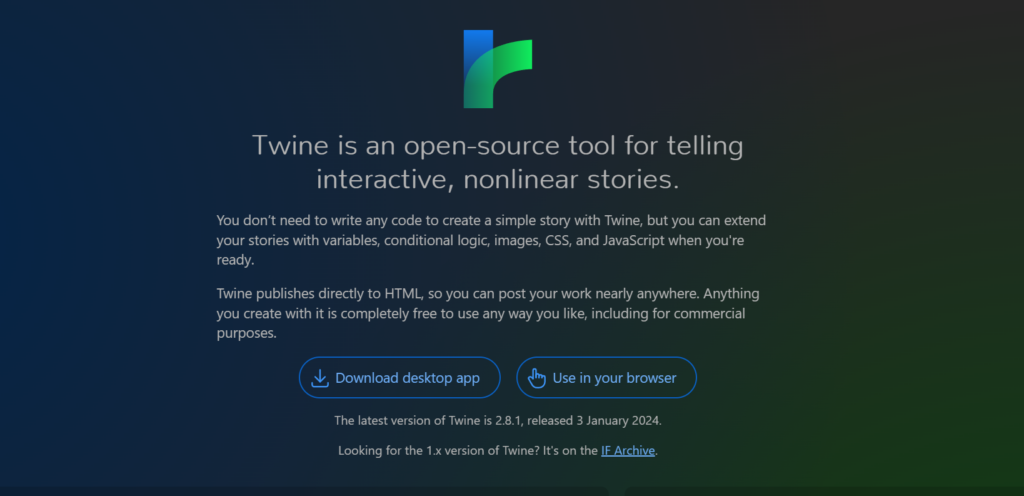
Twine is a great fiction authoring tool because you don’t have to know any code in order to use it. It’s user friendly and you can download the desktop app or use it right in your browser. That opens up plenty of productivity, because you can work on your fiction at your desk, then take it on the go if you have to leave. It’s a simple program that was created by Chris Klimas and is listed as a subsidiary of The Interactive Technology Foundation, a 501(c)(3). It was initially released in 2009, so it’s gone through many versions. The company also released Twine 2, which is the newest version and includes brand new fixes and features. Twine, however, has been around much longer and is considered more stable.
Twine is one of the most accessible and widely used tools for creating interactive fiction. It is an open-source program that allows users to create non-linear, choice-based narratives without requiring programming knowledge. Twine’s drag-and-drop interface makes it easy for beginners to create branching stories, while more advanced users can enhance their projects using CSS and JavaScript. Twine exports stories as HTML files, making them easily shareable online.
What makes Twine a strong competitor, when compared to other programs, is its inclusion of extensions. These extensions can be used to add assets and creativity to your project. You can add conditional logic, CSS, JavaScript, as well as many others to enhance your story. It’s also free to use. Users are encouraged to make donations to the company, but that’s it. It’s a free creation tool that will let you make professional level fiction without knowing a single line of code.
Ink
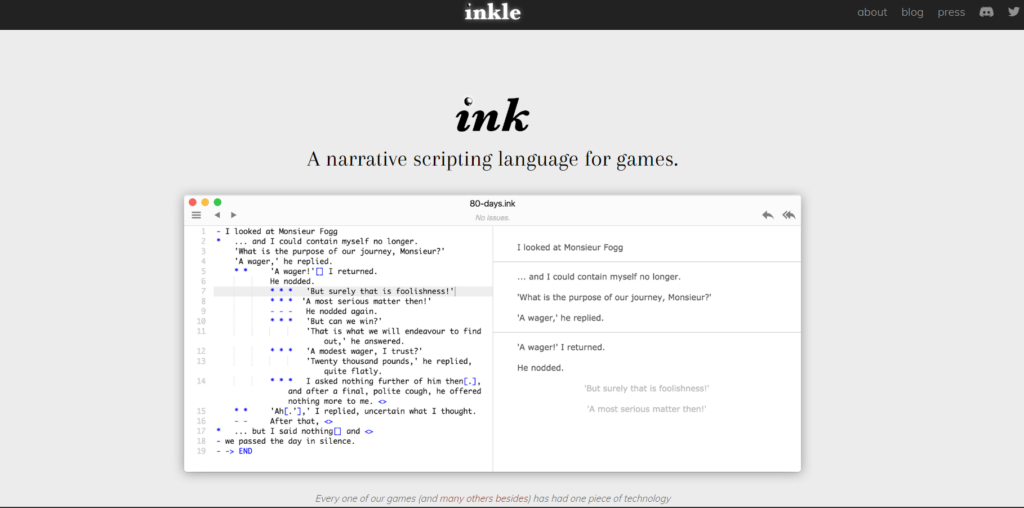
Ink was created in 2011 by two game developers from Cambridge, UK. Joseph Humphrey and Jon Ingold have a passion for storytelling with beautiful design and they set out to create a program that can help people create exactly that. Now Joseph is the company’s art and code director while Jon focuses on narrative direction. They’ve grown to include other employees, such as a 2D artist, a level designer, and a technical developer. Ink can be called a narrative scripting language for games and is very popular among professional game developers. They also have a free version that can be used to create simple narratives to share online.
It is particularly suited for game developers who want to integrate IF elements into their video games. Ink is widely used in professional game development and supports integration with the Unity game engine. The language is relatively easy to learn and offers a flexible approach to branching narratives.
Ink takes all the work out of both narrating and publishing your work. They have features to help you get your game online and on the right platforms for people to play them. It’s meant to be slotted into your game engine to help you with the narrative development of your game. They have plugins to use it in Unity, as well as being open source, so anyone can use it in their engine of choice.
Yarn Spinner
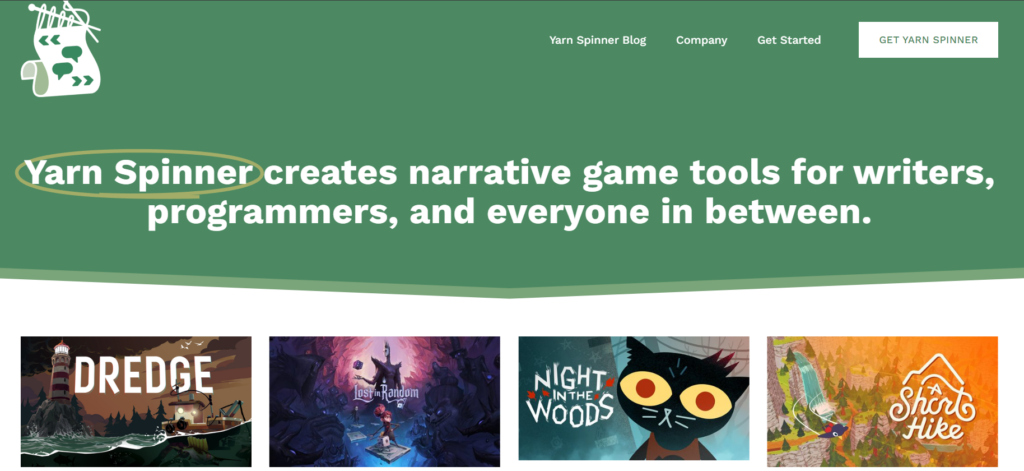
Yarn Spinner is a break away company that formed from Secret Lab. The software was originally created for the award winning game, Night in the Woods, which was released in 2017. It’s now the property of Yarn Spinner Pty. Ltd. and is operated by Jon Maning and Tim Nugent, both former employees of Secret Lab. Paris Buttfield-Addison acts as their director while Mars Buttfield-Addison is their adviser. It’s an Australian company and their software works as a friendly tool for writing game dialogue. It works with Unity and can be closely compared with what Ink is capable of doing.
What sets Yarn Spinner apart is the fact that it’s a premium program with only paid options available. They have a basic version, as well as versions for speech bubbles and dialogue wheels. It’s a tool for writers and programmers, as well as anyone developing their own games with dialogue. The company is currently working on compatibility for the Unreal Engine, and it’s slated for release in early 2024.
Inform 7
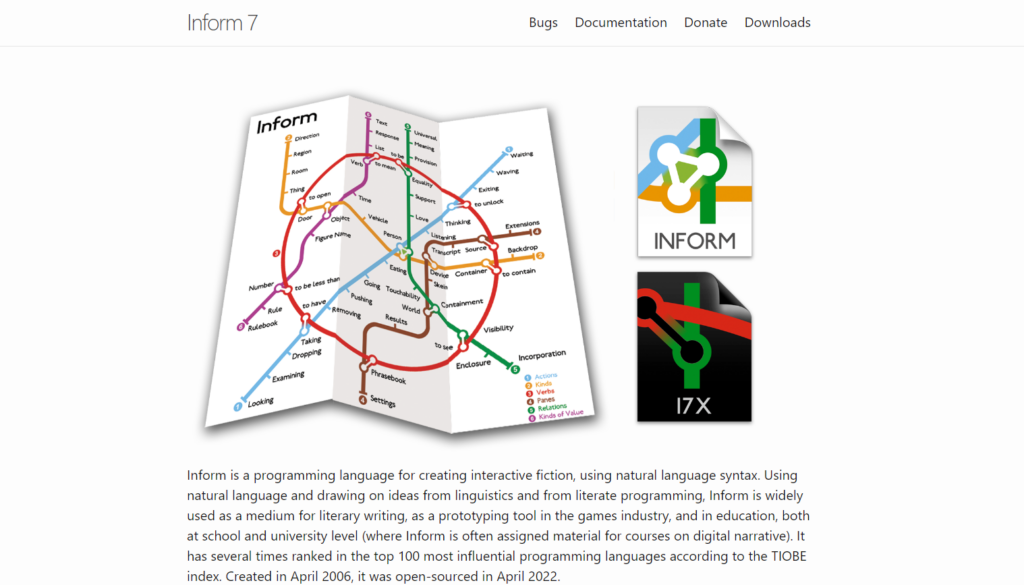
Inform 7 is both a programming language and design system for creating interactive fiction. It was originally created by Graham Nelson in 1993. Its first version was simply called Inform and it’s gone through seven iterations since then. Its latest release came out on August 21, 2022. It supports Microsoft Windows, Mac OS, and Linux. It uses natural language and takes its cues from literate programming and linguistics. That means you can use it without having to understand lots of different coding languages. It’s meant to be understood naturally so developers can start using it without a major learning curve.
Inform 7 is a powerful tool designed for creating text-based interactive fiction in a natural, English-like syntax. Unlike Twine, which is focused on choice-based narratives, Inform 7 excels at creating parser-based fiction, where players type commands to interact with the story world. This tool is ideal for authors who want to develop complex, richly detailed environments. Inform 7 also provides extensive debugging tools and a supportive community for troubleshooting and collaboration.
While Inform 7 may not be as user friendly as the other entries, it’s extremely versatile. In fact, the source code for the program is widely available for anyone to download. That gives users the ability to add their own assets to it. It’s a popular choice among game developers who already have a basic knowledge of adding dialogue to their games but can still be used by newcomers. Many tutorials can be used to understand how it works.
Ren’Py
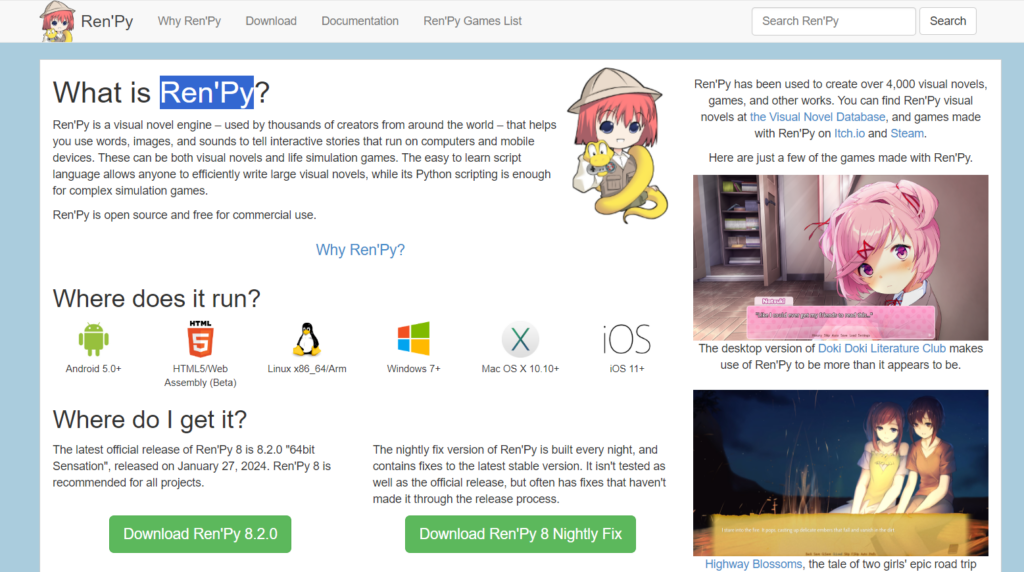
Ren’Py was created by Tom Rothamel in 2004 and it stands as one of the most popular visual novel engines that you can find. Its latest version was released on January 27, 2024 and can be downloaded and used for free. Unlike the other options on this list, Ren’Py is a full game engine that lets you create your projects from start to finish. It’s user friendly and comes with some assets that you can use in your game as well. There are versions for Android, Linux, Windows, Mac OS, and iOS. It can be used to create branching stories, save systems, DLC, transitions, and anything else you might want in your game.
There’s also an active community of developers behind Ren’Py. They’re constantly creating new plug ins and other additions that you can download and add to the program. That gives it lots of versatility, as well as open source code that anyone can use to create their own versions. It’s very user friendly, which makes it possible for anyone with an idea to jump in and start using. It’s an all-around solution that comes with plenty of plug ins to cater the development experience to your needs.
Lots of Programming Options
There are plenty of options to help you create your fictional narrative game and you just have to try the programs to see which one suits your needs the best. Each one has its own benefits but getting your game finished has never been easier or more user friendly.
Conclusion
Interactive fiction is a storytelling medium that allows readers to actively participate in a narrative by making choices that affect the story’s progression. The genre has evolved significantly from early text-based adventures to modern-day interactive experiences. To create these dynamic stories, authors rely on specialized interactive fiction authoring tools. These tools vary in complexity and functionality, catering to different levels of expertise and storytelling styles. Here, we explore some of the most popular IF authoring tools available today.

